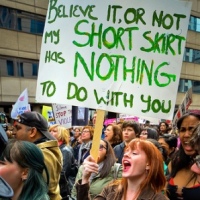On morals campaigner Melinda Tankard Reist’s website you’ll find this breakdown of a survey conducted by Girlfriend magazine on the sexual habits of their young readers. The magazine’s demographic is girls aged between twelve and seventeen.
The survey found that 75% of Girlfriend readers are not sexually active. The reasons given:
- Waiting to be in love (56%)
- Not wanting to have sex (37%)
- Feeling too young (31%)
- No particular reason (26%)
- Waiting to be married (17%)
- Waiting to be the legal age of consent (14%)
- Waiting for their boyfriend/girlfriend to be ready (8%)
- Not being interest in ever having sex (1%)
These reasons don’t appear to differ from reasons given by young women over the last few decades. It’s also possible, though unverifiable I imagine, that over the last few decades 25% of young women have engaged in some kind of sexual activity for a variety of reasons, just as they do today.
The Girlfriend survey appears to contest anecdotes such as those in the article “Stealing the innocence of children” published yesterday in the Fairfax Press. Using language such as onslaught, obsession, bombardment, and phrases such as “placing the child in a sexualised space,” “increasingly sexual and sexualised culture,” “hyenas circling” our young, and “people conditioned to see themselves as ‘product,'” the article paints an alarming picture of an apocalyptically sexualised society, controlled by a terrifyingly nebulous “them.” The closest I can come to identifying “them” are as the manufacturers, producers, distributors and marketers of a perceived “sexualised” and “pornified” popular culture.
They are further identified in the article as “the seamier side of humanity” which has persuaded K-Mart, Target and other retailers to provide children’s clothing modelled on the imagined uniform of sex workers.
Children’s primary carers are obliged to buy this inappropriate clothing and give it to kids to wear, causing them to look “hot” and “sexy.”
It takes a particular kind of perverted vision to see a child as “sexy” or “hot,” no matter what the child is wearing. I do not see children dressed in “sexy” clothing as “hot.”A child dressed like an adult looks to me like a child dressed like an adult. If the child is perceived as “sexualised” or “pornified” it must be the gaze of the adult viewer defining her as such, not the clothing and certainly not the child. It is impossible to “sexualise” and “pornify” a child by dressing her or him in any kind of clothing. Only a sexualising and pornifying gaze can impose that interpretation.
Further, I’d suggest that those currently most responsible for “sexualising” and “pornifying” children’s appearance are the very campaigners who complain most loudly about it. These people are demanding that we all adopt the pedophile gaze, and interpret a child’s appearance as “hot” and “sexy” rather than seeing it for what it is: children imitating adults. There is no innocence lost in the imitation. The innocence is destroyed by the adult’s sexualising gaze.
To others less inclined to make moral judgements based on bits of cloth, children are neither sexualised nor pornified. They are children in bits of cloth, funny, silly, imitating their elders, remarkable or unremarkable, but they are children. If you think they are sexually objectified, the problem is with you.
∫
Is there any space more sexualised than that of an institution such as church or family, in which the child is raped? Is there anymore devastatingly sexualised, objectified and “pornified” child than the child raped in the home, church or other institution outwardly dedicated to her or his welfare? When a child’s body is used to gratify adult desire, that child’s innocence has indeed been destroyed. That child has indeed been sexualised and pornified. And the number of children whose innocence has been thus stolen is incalculable.
Yet is any of this mentioned, even in passing, in an article titled “Stealing the innocence of children?” No. It is not. It is far easier to blame a nebulous “them” for the crime of clothing and music videos.
This is bandaid stuff. What actually demands our attention is the numbers of adults only too willing to see, to describe, and to use children as sexual objects, even those who perceive themselves as being on the side of the good. Campaigners such as Tankard Reist, Steve Biddulph, Emma Rush and Steve Hambleton unwittingly reproduce the pedophile gaze with their own determinedly sexualised readings of popular culture. The pedophile claims in his defence that “she looked like she wanted it,” even if she was only three. The campaigners are in great danger of saying something very similar, albeit for very different reasons.
If you want to protect the innocence of children, don’t impose your sexualising vision on them. If you want to let kids be kids just do it, by recognising that they cannot be sexualised by the clothing they wear, but only by your interpretation of what that clothing signifies.
∫
The campaigners are railing against a particular sexual aesthetic, one that given their reference to sex workers and aspects of popular culture may well be class-based. It’s not so long ago that girls who dressed in a certain way were described as “cheap.” That meant sexually easy, and the girls thus described were not middle class. Today “cheap” garments and attitudes are increasingly infiltrating the middle class, blurring class distinctions and causing what can only be described as a moral panic as those who are well used to controlling an orthodox conservative sexual discourse find themselves challenged as never before.
In another article titled “Save your daughter from the wild-child syndrome,” Steve Biddulph states ” If a girl is going to go wrong, it will be at 14.” If a girl is going to go wrong? This binary of good and bad girls, right and wrong girls, is at the heart of the sexualisation and pornification panic. “Good and right” girls are increasingly indistinguishable from “bad and wrong girls” in their clothing choices. Hell, these days everyone’s looking like hookers and pole dancers! Clothes, once a primary signifier of middle class status and morality, now make “good” girls look like they’re “bad.”
The conservative middle class, whether secular or religious, prescribes a morality that condemns the perceived sexually “easy” girl or woman. There remains, even among the non religious, a code of sexual manners that frowns upon any perceived flaunting of female sexuality.
The morals campaigners are of course never going to question their dogma about how girls and women should express our sexuality. In feminism’s second wave, we learned the folly of unquestioningly accepting the authority of the orthodoxy, and the unnecessary suffering involved in attempting to adjust ourselves to its man-made rules. We need a similar revolution in which we vigorously contest the domination of conservative sexual morality on our culture. Indeed, perhaps such a revolution is already underway, and the current moral panic is the outraged and fearful reaction.
Confusion: just because a girl wears a short skirt doesn’t mean she’s asking for it. On the other hand, the short skirt sexualises, pornifies and objectifies you so if you wear it, you look like a girl going wrong, and asking for it.
∫
The bizarre marriage of radical feminism and right wing religious activism, occasioned to contest that other bogeyman, pornography, is an example of how the desire to censor and control is not confined to the religious. Russell Blackford considers this in his piece on Iceland’s recent initiative to ban certain types of pornography. “You can’t assume that secularism in a country’s population will solve all problems of moralism, anti-sex attitudes, and a general wish by governments and electorates to interfere with people’s lives” Blackford observes. While we know Melinda Tankard Reist comes from a Christian fundamentalist background, and Steve Hambleton is a devout Catholic, their conservative sexual politics are shared and promoted by the non religious as well.
When religious beliefs can’t be invoked to substantiate moralities, psychology, psychiatry and regurgitation of received knowledge is often as, if not more, effective. All of these traditionally accept an initial cultural premise: that there are particular ways of behaving and expressing sexuality that are unquestionably right, and veering from them is wrong. The stranglehold this perspective has on society is currently under great pressure, nowhere as evidenced in the rebellion of the young,who’s collective determination to clothe themselves like porn stars, as the horrified adults would have it, is breaking all the rules of sexual propriety and class.
The extreme manifestation of this propriety is manifested in remarks such as those made by Leader of the Opposition, Tony Abbott, who famously declared that the virginity of his three daughters was the greatest gift they could offer anyone and he hopes they’ll wait till they marry to bestow it.
I recall a sex talk given to us fourteen year olds by the Mother Superior, in which she advised us that we should not be like cream buns in the bakery window. Who, she asked rhetorically, wants to buy a cream bun from which someone else has already taken a lick? It’s only in retrospect I can see the bawdiness of that analogy, and I’m sure Mother Dorothea had no inkling. However, her advice does indicate there were enough girls being cream buns, even several decades ago, for us good girls to be warned of the perils that entailed.
∫
There are, of course, real causes for concern. Five year old girls ought not to be so obsessed about their weight and appearance that their mental and physical health is threatened. I suggest that’s a separate issue from the “sexualisation and pornification” claims, but it is a habit of these campaigners to conflate all the issues (as is exemplified in the Fairfax article) into an “ain’t it awful” catastrophic expectation, won’t somebody think of our children who will save our girls meme.
I can’t watch shows like “Biggest Loser” because of their cruelty,and their commitment to fat-shaming, treacherously disguised as concern. No wonder little girls are scared to death of gaining any weight. They’ve got the message: everyone will hate and shame them if they aren’t reed thin. Many of them have close adult females who angst over their weight, teaching little girls that their lives will be good or bad depending on how much they weigh. I suggest this is far more insidious than any piece of sparkly skimpy cloth K-Mart has on its shelves.
Likewise, the idea of someone dressing a baby in a shirt bearing the slogan “All Daddy wanted was a blow job” is my idea of over-sharing. I’ve never seen such a shirt, though I don’t doubt they exist.
∫
Children have always been born into a “sexualised space.” Planet Earth is a sexualised space, sex is a powerful human drive that everyone encounters, one way or another. Children are sexual beings, and understand from an early age that there is something profoundly mysterious in the adult world that is forbidden to them. Naturally, they want entry into that world, and one of the ways they achieve a semblance of belonging is by imitating adult appearance and behaviour. What kind of a mind construes this imitation as reality, and demands that the rest of us do the same?
What we need to do is really see the children, and not take flight into a moral panic that they cannot understand. There is a child at play inside the “hot” “sexy” clothes. That child shouldn’t have to choose between being a good girl or a bad girl, between going wrong or going right. Adults are responsible for the paucity of role models on offer for children to emulate. If we really care about the children, this is what we’ll address. But that’s going to be a lot harder than blaming K-mart.






































Recent Comments